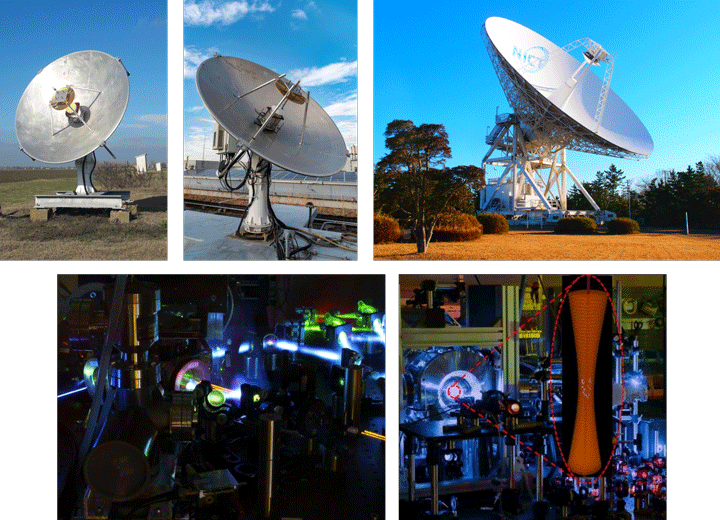Oct 9 2020
Researchers have connected optical atomic clocks on each continent by observing distant stars through radio telescopes.
 Antennas and optical lattice clocks used in the measurements. Upper left: Transportable 2.4-m antenna installed at the INAF radio observatory in Medicina, Italy. Upper middle: Transportable 2.4-m antenna installed at NICT in Koganei, Japan. Upper right: 34-m antenna located at NICT in Kashima, Japan. Bottom left: The ytterbium optical lattice clock IT-Yb1, operated at INRIM in Torino, Italy. Bottom right: The strontium optical lattice clock NICT-Sr1, located at NICT in Koganei, Japan. Image Credit: National Institute of Information and Communications Technology.
Antennas and optical lattice clocks used in the measurements. Upper left: Transportable 2.4-m antenna installed at the INAF radio observatory in Medicina, Italy. Upper middle: Transportable 2.4-m antenna installed at NICT in Koganei, Japan. Upper right: 34-m antenna located at NICT in Kashima, Japan. Bottom left: The ytterbium optical lattice clock IT-Yb1, operated at INRIM in Torino, Italy. Bottom right: The strontium optical lattice clock NICT-Sr1, located at NICT in Koganei, Japan. Image Credit: National Institute of Information and Communications Technology.
The findings were reported in the scientific journal Nature Physics by an international association between 33 astronomers and clock specialists from the National Institute of Information and Communications Technology (NICT, Japan), the Istituto Nazionale di Ricerca Metrologica (INRIM, Italy), the Istituto Nazionale di Astrofisica (INAF, Italy), and the Bureau International des Poids et Mesures (BIPM, France). The BIPM in Sèvres close to Paris regularly computes the international time suggested for civil use (UTC, Coordinated Universal Time) from the comparison of atomic clocks through satellite communications.
But the satellite connections crucial for keeping a synchronized global time have not been able to match with the development of novel atomic clocks—optical clocks that use lasers interacting with ultracold atoms to provide a highly advanced ticking.
To take the full benefit of optical clocks in UTC, it is important to improve worldwide clock comparison methods.
Gérard Petit, Physicist, Time Department, BIPM
In this latest study, highly energetic extragalactic radio sources substitute for satellites as the origin of reference signals. The team of Mamoru Sekido at NICT engineered two unique radio telescopes—one installed in Italy and the other in Japan, to achieve the connection using the method of Very Long Baseline Interferometry (VLBI). Such telescopes can observe across a large bandwidth, while antenna dishes measuring only 2.4 m diameter ensure that they are transportable.
“We want to show that broadband VLBI has potential to be a powerful tool not only for geodesy and astronomy, but also for metrology,” remarked Sekido.
To achieve the desired sensitivity, the small antennas operated in conjunction with a larger 34-m radio telescope deployed in Kashima, Japan, during the measurements taken between October 14th, 2018, and February 14th, 2019. These were among the last observations made with the Kashima radio telescope before the telescope was completely destroyed by typhoon Faxai in September 2019.
The aim of the partnership was to link two optical clocks in Japan and Italy, divided by a baseline distance of 8700 km. These optical clocks load an unlimited number of ultra-cold atoms in an optical lattice—an atomic trap designed with laser light. The clocks use various atomic species: that is, strontium for the clock at NICT and ytterbium for the one at INRIM. Both clocks are candidates for an upcoming re-engineering of the second in the International System of Units (SI).
Today, the new generation of optical clocks is pushing to review the definition of the second. The road to a redefinition must face the challenge of comparing clocks globally, at the intercontinental scale, with better performances than today.
Davide Calonico, Head of Quantum Metrology and Nanotechnology Division and Research Coordinator, INRIM
The connection was achieved by closely watching quasars billions of light-years away: radio sources driven by black holes that weigh millions of solar masses, but so far away that they can be regarded as fixed points in the sky. The telescopes target a different star every few minutes to make up for the impacts of the atmosphere.
We observed the signal not from satellites, but from cosmic radio sources. VLBI may allow us in Asia to access the UTC relying on what we can prepare by ourselves.
Tetsuya Ido, Director of the Space-Time Standards Laboratory and Research Coordinator, NICT
Antennas such as the transportable models used in these kinds of measurements can be directly deployed at the laboratories that create optical clocks worldwide.
Sekido explained, “A global optical clock network connected by VLBI may be realized by collaboration between the international communities of metrology and geodesy, just like the broadband VLBI network of the VLBI Global Observing System (VGOS) has already been established.”
Petit added, “Waiting for long-distance optical links, this research shows that there is still to gain from radio links, where VLBI with transportable antennas can complement the Global Navigation Satellite Systems and telecommunication satellites.”
Apart from enhancing international timekeeping, such infrastructure also paves the way to explore fundamental physics and general relativity, to investigate variations of Earth’s gravitational field, or even the difference of the underlying fundamental constants in physics.
Federico Perini, the coordinator of the study at INAF, stated, “We are proud to have been part of this collaboration helping to achieve such a big step forward in developing a technique which, using the most distant radio sources in the Universe, makes possible the measurement of the frequencies generated by two of the most accurate clocks here on the Earth.”
“Our comparison using VLBI gives a new perspective to improve and investigate new methods for clock comparisons, also looking at the contamination between different disciplines,” Calonico concluded.
Journal Reference:
Pizzocaro, M., et al. (2020) Intercontinental comparison of optical atomic clocks through very long baseline interferometry. Nature Physics. doi.org/10.1038/s41567-020-01038-6.